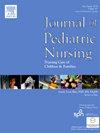The relationship between secondary traumatic stress levels of pediatric nurses and their emotional intelligence and sociodemographic factors
IF 2.3
4区 医学
Q2 NURSING
Journal of Pediatric Nursing-Nursing Care of Children & Families
Pub Date : 2025-09-17
DOI:10.1016/j.pedn.2025.09.007
引用次数: 0
Abstract
Purpose
This study was conducted to determine the relationship between the level of secondary traumatic stress in pediatric nurses and socio-demographic & professional factors, as well as emotional intelligence.
Design and methods
This descriptive and correlational study involved 138 pediatric nurses. Data were collected using the “Sociodemographic and Professional Data Form”, “Secondary Traumatic Stress Scale” and “Schutte Self-Report Emotional Intelligence Test”. Statistical analyses included Shapiro-Wilk test, Mann-Whitney U test, Kruskal-Wallis variance analysis, Spearman correlation analysis, and multiple linear stepwise regression analysis.
Results
It was concluded that pediatric nurses' secondary traumatic stress levels were moderate. Pediatric nurses' evaluations of social support from their surroundings (p < 0.001) and their choosing the profession willingly (p < 0.05) were found to be associated with and affecting their levels of secondary traumatic stress. A low, negative significant relationship was found between the secondary traumatic stress levels and emotional intelligence levels of pediatric nurses (p < 0.05). Emotional intelligence was not found to impact secondary traumatic stress.
Conclusion
According to the results, social support from surroundings and choosing profession willingly may reduce secondary traumatic stress levels of pediatric nurses'.
Implications for practice
In order to reduce the secondary traumatic stress exposure of pediatric nurses, it has been revealed that nurses who choose the profession willingly and are happy to work in the pediatric unit should be supported, strategies should be developed to increase the social support received from the surroundings, and studies should be carried out to increase the emotional intelligence levels of pediatric nurses.
儿科护士继发性创伤应激水平与情绪智力及社会人口因素的关系。
目的:探讨儿科护士继发性创伤应激水平与社会人口统计学、专业因素及情绪智力的关系。设计与方法:本研究涉及138名儿科护士。采用《社会人口学与专业数据表》、《二次创伤应激量表》和《舒特自述情绪智力测验》进行数据收集。统计分析包括Shapiro-Wilk检验、Mann-Whitney U检验、Kruskal-Wallis方差分析、Spearman相关分析和多元线性逐步回归分析。结果:儿科护士继发性创伤应激水平处于中等水平。结论:环境社会支持和自愿职业选择可以降低儿科护士的二次创伤应激水平。实践启示:为减少儿科护士的二次创伤应激暴露,应支持自愿选择职业并乐于在儿科工作的护士,制定策略以增加从周围环境中获得的社会支持,并开展研究以提高儿科护士的情商水平。
本文章由计算机程序翻译,如有差异,请以英文原文为准。
求助全文
约1分钟内获得全文
求助全文
来源期刊

Journal of Pediatric Nursing-Nursing Care of Children & Families
NURSING-PEDIATRICS
CiteScore
3.70
自引率
8.30%
发文量
291
审稿时长
65 days
期刊介绍:
Official Journal of the Society of Pediatric Nurses and the Pediatric Endocrinology Nursing Society (PENS)
The Journal of Pediatric Nursing: Nursing Care of Children and Families (JPN) is interested in publishing evidence-based practice, quality improvement, theory, and research papers on a variety of topics from US and international authors. JPN is the official journal of the Society of Pediatric Nurses and the Pediatric Endocrinology Nursing Society. Cecily L. Betz, PhD, RN, FAAN is the Founder and Editor in Chief.
Journal content covers the life span from birth to adolescence. Submissions should be pertinent to the nursing care needs of healthy and ill infants, children, and adolescents, addressing their biopsychosocial needs. JPN also features the following regular columns for which authors may submit brief papers: Hot Topics and Technology.
 求助内容:
求助内容: 应助结果提醒方式:
应助结果提醒方式:


